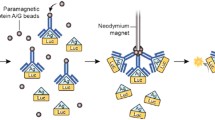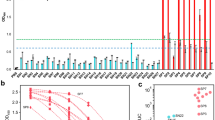Abstract
Sampling the blood compartment by an invasive procedure such as phlebotomy is the most common approach used for diagnostic purposes. However, phlebotomy has several drawbacks including pain, vasovagal reactions, and anxiety. Therefore, alternative approaches should be tested to minimize patient’s discomfort. Saliva is a reasonable compartment; when obtained, it generates little or no anxiety. We setup a multiplexed serology assay for detection of Toxoplasma gondii IgG and IgM, rubella IgG, and CMV IgG, in serum, whole blood, and saliva using novel plasmonic gold (pGOLD) chips. pGOLD test results in serum, whole blood, and saliva were compared with commercial kits test results in serum. One hundred twenty serum/saliva sets (Lyon) and 28 serum/whole blood/saliva sets (Nice) from France were tested. In serum and whole blood, sensitivity and specificity of multiplex T. gondii, CMV, and rubella IgG were 100% in pGOLD when compared to commercial test results in serum. In saliva, sensitivity and specificity for T. gondii and rubella IgG were 100%, and for CMV IgG, sensitivity and specificity were 92.9% and 100%, respectively, when compared to commercial test results in serum. We were also able to detect T. gondii IgM in saliva with sensitivity and specificity of 100% and 95.4%, respectively, when compared to serum test results. Serological testing by multiplex pGOLD assay for T. gondii, rubella, and CMV in saliva is reliable and likely to be more acceptable for systematic screening of pregnant women, newborn, and immunocompromised patients.



Similar content being viewed by others
References
Yoshizawa JM, Schafer CA, Schafer JJ, Farrell JJ, Paster BJ, Wong DTW (2013) Salivary biomarkers: toward future clinical and diagnostic utilities. Clin Microbiol Rev 26:781–791. https://doi.org/10.1128/CMR.00021-13
Exum NG, Pisanic N, Granger DA, Schwab KJ, Detrick B, Kosek M et al (2016) Use of pathogen-specific antibody biomarkers to estimate waterborne infections in population-based settings. Curr Environ Health Rep 3:322–334. https://doi.org/10.1007/s40572-016-0096-x
Stekler JD, Ure G, O’Neal JD, Lane A, Swanson F, Maenza J et al (2016) Performance of determine combo and other point-of-care HIV tests among Seattle MSM. J Clin Virol 76:8–13. https://doi.org/10.1016/j.jcv.2015.12.011
Augustine SAJ (2016) Towards universal screening for toxoplasmosis: rapid, cost-effective, and simultaneous detection of anti-Toxoplasma IgG, IgM, and IgA antibodies by use of very small serum volumes. J Clin Microbiol 54:1684–1685. https://doi.org/10.1128/JCM.00913-16
Li X, Pomares C, Gonfrier G, Koh B, Zhu S, Gong M et al (2016) Multiplexed anti-Toxoplasma IgG, IgM, and IgA assay on plasmonic gold chips: towards making mass screening possible with dye test precision. J Clin Microbiol 54:1726–1733. https://doi.org/10.1128/JCM.03371-15
Pomares C, Zhang B, Arulkumar S, Gonfrier G, Marty P, Zhao S et al (2017) Validation of IgG, IgM multiplex plasmonic gold platform in French clinical cohorts for the serodiagnosis and follow up of Toxoplasma gondii infection. Diagn Microbiol Infect Dis [cited 2016 28]; http://www.sciencedirect.com/science/article/pii/S0732889316302863. https://doi.org/10.1016/j.diagmicrobio.2016.09.001
Yazigi A, Pecoulas AED, Vauloup-Fellous C, Grangeot-Keros L, Ayoubi J-M, Picone O (2016) Fetal and neonatal abnormalities due to congenital rubella syndrome: a review of literature. J Matern Fetal Neonatal Med 22(0):1–5. https://doi.org/10.3109/14767058.2016.1169526
Hui L, Wood G (2015) Perinatal outcome after maternal primary cytomegalovirus infection in the first trimester: a practical update and counseling aid. Prenat Diagn 35:1–7. https://doi.org/10.1002/pd.4497
Picone O, Grangeot-Keros L, Senat M, Fuchs F, Bouthry E, Ayoubi J et al (2016) Cytomegalovirus non-primary infection during pregnancy. Can serology help with diagnosis? J Matern Fetal Neonatal Med 5:1–4. https://doi.org/10.3109/14767058.2016.1169521
Chapey E, Meroni V, Kieffer F, Bollani L, Ecochard R, Garcia P et al (2015) Use of IgG in oral fluid to monitor infants with suspected congenital toxoplasmosis. Clin Vaccine Immunol 22:398–403. https://doi.org/10.1128/CVI.00552-14
Sabin AB, Feldman HA (1948) Dyes as microchemical indicators of a new immunity phenomenon affecting a protozoon parasite (toxoplasma). Science 108:660–663. https://doi.org/10.1126/science.108.2815.660
Zhang B, Yang J, Zou Y, Gong M, Chen H, Hong G et al (2014) Plasmonic micro-beads for fluorescence enhanced, multiplexed protein detection with flow cytometry. Chem Sci 26(5):4070–4075. https://doi.org/10.1039/C4SC01206B
Tabakman SM, Lau L, Robinson JT, Price J, Sherlock SP, Wang H et al (2011) Plasmonic substrates for multiplexed protein microarrays with femtomolar sensitivity and broad dynamic range. Nat Commun 2:466. https://doi.org/10.1038/ncomms1477
Koh B, Li X, Zhang B, Yuan B, Lin Y, Antaris AL et al (2016) Visible to near-infrared fluorescence enhanced cellular imaging on plasmonic gold chips. Small 27(12):457–465. https://doi.org/10.1002/smll.201502182
Zhang B, Price J, Hong G, Tabakman SM, Wang H, Jarrell JA et al (2013) Multiplexed cytokine detection on plasmonic gold substrates with enhanced near-infrared fluorescence. Nano Res 6:113–120. https://doi.org/10.1007/s12274-012-0286-2
Zhang B, Kumar RB, Dai H, Feldman BJ (2014) A plasmonic chip for biomarker discovery and diagnosis of type 1 diabetes. Nat Med 20:948–953. https://doi.org/10.1038/nm.3619
Pomares C, Montoya JG (2016) Laboratory diagnosis of congenital toxoplasmosis. J Clin Microbiol 54:2448–2454. https://doi.org/10.1128/JCM.00487-16
Cortina-Borja M, Tan HK, Wallon M, Paul M, Prusa A, Buffolano W et al (2010) Prenatal treatment for serious neurological sequelae of congenital toxoplasmosis: an observational prospective cohort study. PLoS Med 7. https://doi.org/10.1371/journal.pmed.1000351
Hotop A, Hlobil H, Gross U (2012) Efficacy of rapid treatment initiation following primary Toxoplasma gondii infection during pregnancy. Clin Infect Dis 54:1545–1552. https://doi.org/10.1093/cid/cis234
Kieffer F, Wallon M, Garcia P, Thulliez P, Peyron F, Franck J (2008) Risk factors for retinochoroiditis during the first 2 years of life in infants with treated congenital toxoplasmosis. Pediatr Infect Dis J 27:27–32. https://doi.org/10.1097/INF.0b013e318134286d
Prusa A-R, Kasper DC, Pollak A, Gleiss A, Waldhoer T, Hayde M (2015) The Austrian Toxoplasmosis Register, 1992-2008. Clin Infect Dis 15(60):e4–e10. https://doi.org/10.1093/cid/ciu724
Wallon M, Peyron F, Cornu C, Vinault S, Abrahamowicz M, Kopp CB et al (2013) Congenital Toxoplasma infection: monthly prenatal screening decreases transmission rate and improves clinical outcome at age 3 years. Clin Infect Dis 56:1223–1231. https://doi.org/10.1093/cid/cit032
SYROCOT (Systematic Review on Congenital Toxoplasmosis) study group, Thiébaut R, Leproust S, Chêne G, Gilbert R (2007) Effectiveness of prenatal treatment for congenital toxoplasmosis: a meta-analysis of individual patients’ data. Lancet 369:115–122. https://doi.org/10.1016/S0140-6736(07)60072-5
Carlson A, Norwitz ER, Stiller RJ (2010) Cytomegalovirus infection in pregnancy: should all women be screened? Rev Obstet Gynecol 3:172–179
Rawlinson WD, Hamilton ST, van Zuylen WJ (2016) Update on treatment of cytomegalovirus infection in pregnancy and of the newborn with congenital cytomegalovirus. Curr Opin Infect Dis 29:615–624. https://doi.org/10.1097/QCO.0000000000000317
Rawlinson WD, Boppana SB, Fowler KB, Kimberlin DW, Lazzarotto T, Alain S et al (2017) Congenital cytomegalovirus infection in pregnancy and the neonate: consensus recommendations for prevention, diagnosis, and therapy. Lancet Infect Dis 17:e177–e188. https://doi.org/10.1016/S1473-3099(17)30143-3
Bouthry E, Picone O, Hamdi G, Grangeot-Keros L, Ayoubi J-M, Vauloup-Fellous C (2014) Rubella and pregnancy: diagnosis, management and outcomes. Prenat Diagn 34:1246–1253. https://doi.org/10.1002/pd.4467
Stillwaggon E, Carrier CS, Sautter M, McLeod R (2011) Maternal serologic screening to prevent congenital toxoplasmosis: a decision-analytic economic model. PLoS Negl Trop Dis 5:e1333. https://doi.org/10.1371/journal.pntd.0001333
Funding
Christelle Pomares received a grant from the “Philippe Foundation Inc.,” the “Association des amis de la Faculté de Médecine de Nice,” and from REDPIT (Recherche Et Developpement En Pathologie Infectieuse Et Tropicale) association. These associations allowed a personal financial support during the post-doctoral period in the USA.
Author information
Authors and Affiliations
Corresponding authors
Ethics declarations
This study was approved by the local ethical committees for the prospective collection of samples (Comité de protection des personnes (CPP) Teaching hospitals of Lyon and Nice, France).
Conflict of interest
The authors declare that they have no conflict of interest.
Additional information
Publisher’s note
Springer Nature remains neutral with regard to jurisdictional claims in published maps and institutional affiliations.
Rights and permissions
About this article
Cite this article
Li, X., Pomares, C., Peyron, F. et al. Plasmonic gold chips for the diagnosis of Toxoplasma gondii, CMV, and rubella infections using saliva with serum detection precision. Eur J Clin Microbiol Infect Dis 38, 883–890 (2019). https://doi.org/10.1007/s10096-019-03487-1
Received:
Accepted:
Published:
Issue Date:
DOI: https://doi.org/10.1007/s10096-019-03487-1




